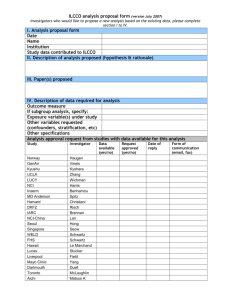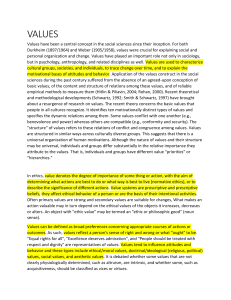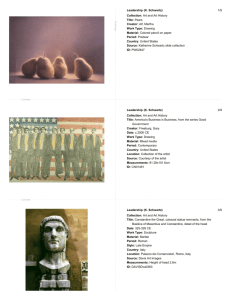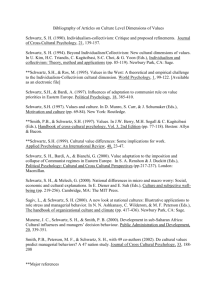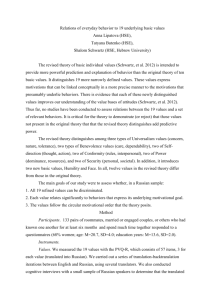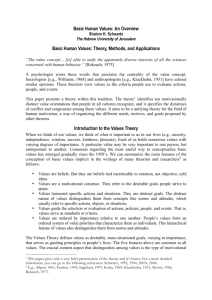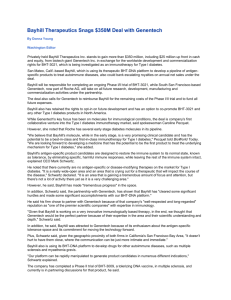Schwartz Value Theory: Understanding Human Values
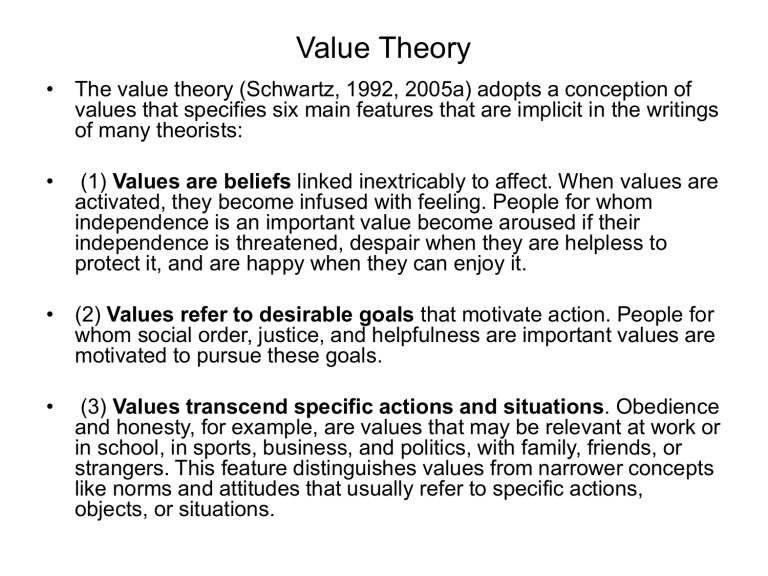
Value Theory
• The value theory (Schwartz, 1992, 2005a) adopts a conception of values that specifies six main features that are implicit in the writings of many theorists:
• (1) Values are beliefs linked inextricably to affect. When values are activated, they become infused with feeling. People for whom independence is an important value become aroused if their independence is threatened, despair when they are helpless to protect it, and are happy when they can enjoy it.
• (2) Values refer to desirable goals that motivate action. People for whom social order, justice, and helpfulness are important values are motivated to pursue these goals.
• (3) Values transcend specific actions and situations . Obedience and honesty, for example, are values that may be relevant at work or in school, in sports, business, and politics, with family, friends, or strangers. This feature distinguishes values from narrower concepts like norms and attitudes that usually refer to specific actions, objects, or situations.
Value Theory (cont’d)
• (4) Values serve as standards or criteria. Values guide the selection or evaluation of actions, policies, people, and events. People decide what is good or bad, justified or illegitimate, worth doing or avoiding, based on possible consequences for their cherished values. But the impact of values in everyday decisions is rarely conscious. Values enter awareness when the actions or judgments one is considering have conflicting implications for different values one cherishes.
• (5) Values are ordered by importance relative to one another. People’s values form an ordered system of value priorities that characterize them as individuals. Do they attribute more importance to achievement or justice, to novelty or tradition? This hierarchical feature also distinguishes values from norms and attitudes.
•
• (6) The relative importance of multiple values guides action. Any attitude or behavior typically has implications for more than one value. For example, attending church might express and promote tradition, conformity, and security values at the expense of hedonism and stimulation values. The tradeoff among relevant, competing values is what guides attitudes and behaviors (Schwartz, 1992, 1996). Values contribute to action to the extent that they are relevant in the context (hence likely to be activated) and important to the actor.
[1] e.g., Allport, 1961; Feather, 1995; Inglehart, 1997; Kohn, 1969; Kluckhohn, 1951; Morris, 1956; Rokeach 1973; Schwartz & Bilsky, 1987.
Schwartz Value Survey
• Schwartz tested his 10 value type model developing the
Schwartz Value Survey an instrument now widely used in behavioral science studies. This rating scale consisting of 57 value items of which it has been reported that 44 were identified as the predicted value type in at least 75 percent of the 97 samples from 44 countries (Schwartz, 1994)
• Schwartz also tested an eleventh possible universal value, 'spirituality, or 'the goal of finding meaning in life, but found that it does not seem to be recognized in all cultures (Spini, 2003).
The Structure of Value
Relations
Schwartz Value Theory
Based on these needs Schwartz (1992) conceived a circular structure model consisting of 10 value types which included
: See Page 5
• power (attainment of social status and prestige, and control or dominance over people or resources) I - Self-Enhancement
• achievement (personal success through the demonstration of competence according to social standards I - Self-Enhancement
• hedonism (pleasure and sensuous gratification for oneself) I – Self-Enhancement
• stimulation (excitement, novelty, challenge in life)
Openness to Change
• self-direction (independent thought and action)
Openness to Change
• universalism ( understanding, appreciating, tolerance, and protection for the welfare of all people and for nature) C - Self-Transcendence
• benevolence (concern for the welfare of others in everyday interaction) C – Self-Transcendence
• tradition (respect, commitment and acceptance of the customs and ideas that one’s culture or religion impose on the individual) C- Conservation
• conformity (restraint of actions, inclination, and impulses likely to upset or harm others and violate social expectations or norms) C-Conservation
• security ( safety, harmony, and stability of society, of relationships, and of the self) C-Conservation
Structure of Value Relations
• Actions in pursuit of any value have consequences that conflict with some values but are congruent (fit) with others.
• Example: (Page 9)
– Pursuing achievement values typically conflicts with pursuing benevolence values
(seeking success for self tends to obstruct actions aimed at enhancing the welfare of others)
– But pursuing achievement values typically is compatible with pursuing power values ( seeking personal success for oneself tends to strengthen and to be strengthened by actions aimed at enhancing ones own social position and authority over others)
Example (cont’d)
• Pursuing novelty and change (stimulation values) is likely to undermine preserving time honored customs (traditional values)
• In contrast, pursuing traditional values is congruent (fit) pursuing conformity values as both values motivate actions of submission to external expectations
Super Groups and Opposition between
Competing Values
(page 10)
• Openness to Change and Conservation Values
– Dimension captures the conflict between values that emphasize independence of thought, action, and feelings and readiness for change (self-direction, stimulation) and values that emphasize that emphasize order, self-restriction, preservation of the past, resistance to change (security, conformity, tradition)
Super Groups and Opposition between
Competing Values
(page 10)
• Self-Enhancement and Self Transcendence Values
– Dimension captures the conflict between values that emphasize concern for the welfare and interests of others (universalism, benevolence) and values that emphasize pursuit of one’s own interests and relative success and dominance over others (power, achievement)
Hedonism shares elements of both openness to change and self-enhancement
Value SVS Items
Conformity 11,20,40,47
Tradition 18,32,36,44,51,
Benevolence 33,45,49,52,54
Universalism 1,17,24,26,29,30,35,38
Self-Direction 5,16,31,41,53
Stimulation 9,25,37
Hedonism 4,50,57
Achievement 34,39,43,55
Power 3,12,27,46
Security 8,13,15,22,56
